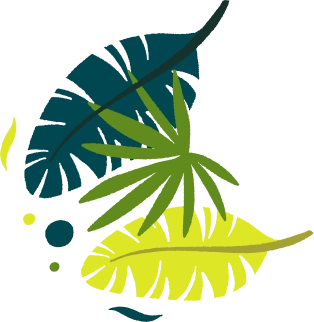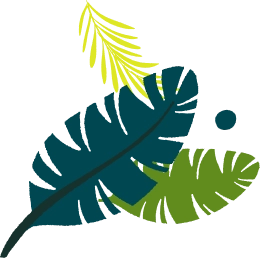


Vietnam grows some of the world's most exotic tropical fruits. We cover top 10 Vietnamese fruits including dragon fruit, durian, mangosteen, rambutan, star apple, and rose apple. Each fruit section includes what it looks like, how it tastes, health benefits and nutrition facts, when it's in season, where to find it in Hanoi and Ho Chi Minh City markets, and how to eat it.
We will help you find out which Vietnamese fruit to try when, where to buy it, and what to expect when eating Vietnam's most iconic tropical delicacies.
Appearance & Taste: The appearance is striking, with vibrant pink or yellow skin and cool speckled white or red insides; it has this mild sweetness that somewhat gives off the flavor mixture between pear and kiwi.
You can mostly find it in Bình Thuận and Ninh Thuận provinces, and it's around all year long.
How to use: Cut it open, scoop out the pulp, and enjoy it raw or in smoothies. Refreshing and great on hot summer days.
Appearance and Taste: This hairy fruit is home to a translucent inner juicy pulp, sweet but slightly sour, just like a lychee.
Rambutan is normally harvested twice in a year; during summer and winter seasons.
How to Enjoy: The fruit inside will be expressed by gentle squeezing and twisting of the rind; eat as is.
Appearance & Taste: Mangosteen, popularly referred to as the "queen of fruits," is wrapped by a thick, purple rind covering delicate, sweet-and-sour white segments.
High Season: April to October.
You can find it pretty much all over the Mekong Delta area.
Pro Tip: Using a knife, cut only the rind so that you do not crush the juicy interior.
Description: Called the "king of fruits," durian has a spiky outer shell and a strong, pungent smell, with flesh that is creamy and sweet or custard-like.
Season: Commonest between June and August.
How to Enjoy: Fresh or in desserts, such as ice cream and smoothies. Be cautious: its pungent smell is polarizing among tourists. It's one of those either you love it or hate it when you eat it the first time!
Appearance and Taste: This round fruit has green or purple skin that houses sweet, milky flesh inside, which is all jelly-like.
Best time? From September to April.
How to use it: Cut it open and then scoop it with a spoon or press and roll it to get the juice out.
It's a small, pear-shaped fruit that has green skin, while inside it can be pink or white; it is sweet, kind of herbal, and has crunchy seeds.
Availability: Year-round.
How to Enjoy: Eat fresh slices with chili salt, or make refreshing juices from a blend.
Appearance & Taste: Pomelo is a large citrus fruit, with juicy, sac-filled segments and is less acidic than grapefruit.
Where to Find: Most markets throughout the country, especially in the Mekong Delta.
How to enjoy it: With this fruit, peel away the thick rind and pith to get to its juicy flesh-salad or just plain eating with a dash of chili salt is great.
Appearance and Taste: Well, it's this oval, brown fruit, with this ultra-soft, caramel-like flesh; sweet and somewhat grainy, like brown sugar.
Best Season: From late summer to early winter.
How to enjoy: You can eat it raw or throw it into desserts like ice cream.
Appearance & Taste: This bumpy green fruit has this creamy, tasty flesh that kinda smells like vanilla. So, like summer to early autumn.
How to Enjoy: Scoop out the pulp and enjoy, or toss it in with some smoothies for a fun tropical vibe. It is one of our favourite fruits we tried in Vietnam.
So, rose apples are kind of bell-shaped, and they are really crispy and juicy. They taste like unripe pears, somewhat, but with a nice floral hint.
Best Season: Grows year-round in southern Vietnam.
How to Enjoy: Generally eaten whole, or sliced and then enjoyed with chilli salt.
Dong Xuan Market: Old Quarter location, best for tourists, English-speaking vendors, reasonable prices. Morning best (7-9 AM), Afternoon crowded
Address: 100 Hang Dieu St, Hanoi Old Quarter
Tips: Prices 20% higher than local Vietnamese markets, but cleanest option
Old Quarter Street Vendors: Best price and freshness, small wooden carts, seasonal fruit rotates daily. Afternoon (3-5 PM) best time
Ben Thanh Market: Most famous, tourist hub, largest selection. Arrive early for best fruits. Prices moderate
Address: Le Thanh Tong St, District 1
Tips: Can negotiate prices, ask vendors to give samples before buying
Cho Ba Chieu: Hidden gem, more local atmosphere, lower prices than Ben Thanh, authentic market experience
Address: Ba Chieu Street, District 1
Tips: Fewer tourists, vendors speak limited English, cash only
Cai Rang Floating Market: Iconic experience, fruits sold directly from boats, vendors display samples on tall poles
Best Time: Early morning (6-8 AM)
Tips: Tour companies offer 4-6 hour tours, usually cheaper to go with group
Smell the fruit (except durian!) - smell indicates ripeness, Never buy pre-cut fruit - always buy whole and eat fresh, Ask vendors "mua lúc nào ăn?" (when should I eat this?) - they know ripeness timeline, Visit early morning for best selection, Bring small bills - change is often in fruit discounts not cash
Many people search for "vietnamese pear" but this fruit doesn't actually exist by that name. The confusion comes from fruits that look pear-shaped or have similar texture. Here's what you're actually looking for:
Vietnamese Pear is Actually:
Guava (Ổi): Green or pink fleshy interior, pear-shaped, sweet with slight herbal notes. Found year-round. Cost: 20,000 to 40,000 VND per kg.
Custard Apple (Mâm Cầu): Bumpy exterior, pear-ish shape, creamy vanilla-like flesh. September to April. Cost: 30,000 to 50,000 VND per kg.
Star Apple (Vú Sữa): Round fruit with star pattern when cut, milky sweet flesh, sometimes mistaken for pear due to texture. September to April. Cost: 40,000 to 60,000 VND per kg.
Mini Tip: When shopping at Vietnamese markets, ask vendors "quả nào giống lê" (which fruit is like a pear?). Locals understand the confusion and will point you to guava or custard apple.
Vietnam grows fruit year-round, but seasonality affects price, flavor, and availability. Visit Vietnam during the right season and pay half the price while tasting better fruit.
Spring (March to May)
Dragon fruit (year-round but peak), Mango season begins, Pineapple, Lychee
Best for: Tropical fruit variety increasing
Summer (June to August)
Rambutan, Mangosteen, Durian (peak), Longan
Best for: If you want to try durian and mangosteen, this is your season
Autumn (September to November)
Star Apple, Custard Apple, Pomelo, Guava
Best for: Best variety available, most affordable prices
Winter (December to February)
Oranges, Tangerines, Bananas, Continued guava
Best for: Citrus fruits, best deals
Year-Round:
Dragon fruit, Mango, Banana, Papaya
Money-Saving Tip: Buy fruits during peak season when abundant and cheap. A mango in July costs 5,000 VND. Same mango in February costs 15,000 VND.
Vietnam's tropical fruits aren't just delicious, they're nutritional powerhouses. Here's what each fruit does for your health.
Dragon Fruit
Fiber for digestion, Low calorie (just 60 per fruit), Vitamin C for immune system, Helps with weight loss, Prebiotic feeds good gut bacteria
Mango
Beta-carotene for eyesight, Enzymes that reduce inflammation, Fiber for digestive health, Natural enzymes that fight arthritis, Used in traditional medicine for 4,000+ years
Rambutan
72 calories per cup, Vitamin C (50% of daily needs in 5-6 fruits), Copper for brain and heart health, Supports digestion, Antimicrobial properties
Durian
Despite its smell, packed with: Vitamin B6 (brain function), Manganese (bone health), Tryptophan (mood and sleep)
Mangosteen
High in antioxidants, Xanthones (unique compounds found only here), Reduces inflammation, Anti-cancer potential (under research), Called "superfood" by health experts
Q1: What does durian taste like if it smells so bad?
Sweet, buttery, creamy. Flavor contradicts the aroma completely. Often described as custardy or almond-like with hints of caramel. Once you eat it, the smell stops bothering you because the taste is so good.
Q2: Is dragon fruit actually exciting or is it boring like I heard?
Boring flavor-wise (very mild, almost bland), but incredible health benefits. Most Vietnamese eat it as a palate cleanser after meals, not as a main attraction. It's more about the nutrition and visual appeal than taste.
Q3: Can I buy Vietnamese fruits outside Vietnam?
Yes, in Asian markets in major cities. Quality is 30-50% lower than fresh Vietnam fruits. Best option online through specialty importers but expensive. If possible, try fruits while in Vietnam.
Q4: What's the difference between mangosteen and star apple?
Mangosteen: Purple rind, white segments, sweet-and-sour, soft texture, premium fruit
Star Apple: Purple/green skin, star pattern inside, milky creamy, sweeter, less acidic
Both delicious but different experiences. Try both if possible.
Q5: Is Rambutan actually like lychee?
Similar but distinct. Rambutan is bigger, hairier, slightly juicier. Flavor very similar but rambutan is slightly sweeter. If you like lychee, you'll love rambutan. Cost similar too.
Q6: How do I know when a fruit is ripe to eat?
Ask vendors. They know the exact day each fruit was picked and predict ripeness. Mango ready today? Durian ready tomorrow? Mangosteen ready in 2 days? Vendors know. Trust their timing.
Q7: Can I bring Vietnamese fruits back to my country?
Depends on your country's customs. USA allows many (dragon fruit, mango, durian), EU restricts durian. Check customs before buying. Some fruits must be declared, others forbidden.
Q8: What's the most expensive Vietnamese fruit?
Durian. $5-15 USD per fruit depending on quality and season. Mangosteen also expensive ($3-7) when out of season. Cheapest: banana, guava, papaya ($0.30-1).
Q9: Are Vietnamese fruits safe to eat for tourists?
Yes. Wash thoroughly before eating. Peel when possible. Avoid pre-cut fruit from unknown vendors. Buy from established markets. Your stomach might adjust to local fruit enzymes (normal, not dangerous).
Q10: Which fruit should I try first as a beginner?
Mango (universally loved), Dragon fruit (visually impressive, easy to eat), Rambutan (similar to lychee, not intimidating). Skip durian on first trip unless adventurous. Durian is love-it-or-hate-it.
Get the latest information about our tours and special offers!